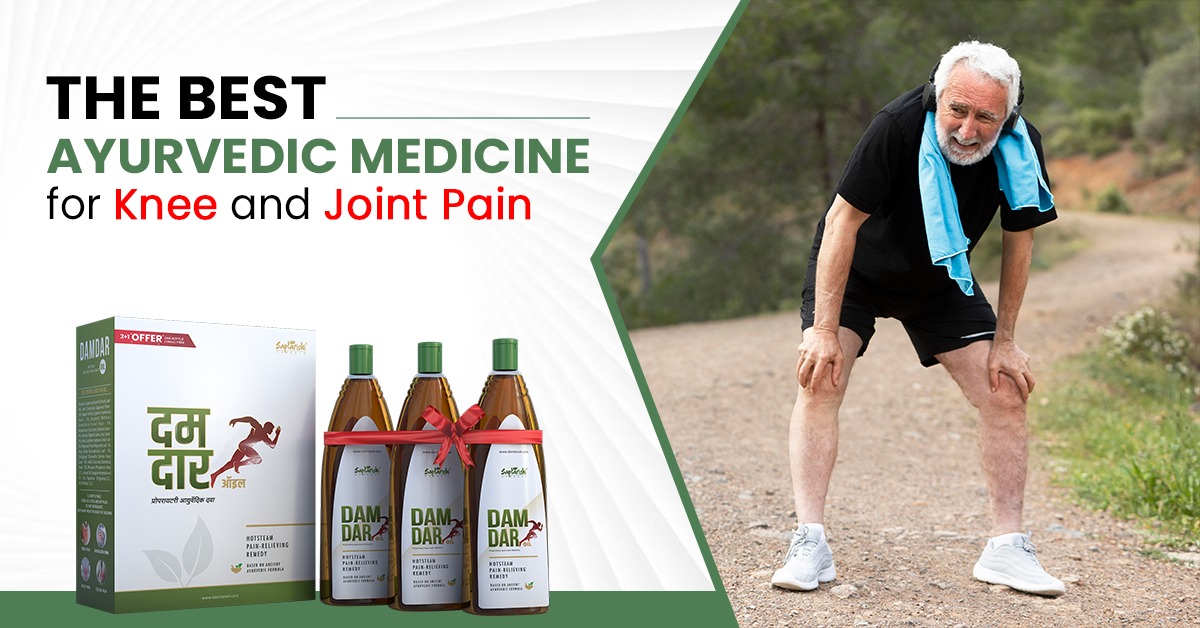The Best Ayurvedic Medicine for Knee and Joint Pain

Knee pain is no longer just an old age problem or something that comes from an injury. In today’s digital world, more and more young adults and working professionals are experiencing knee discomfort, chronic pain, or stiffness. The shocking fact? Too much sitting. And we thought that only physical activities requiring long hours of standing would cause knee pain.
So, it’s not always the wear and tear of knee muscles that results in knee pain, but also inactivity during long desk jobs, long car rides, or hours spent scrolling through your phone. Our bodies weren’t meant for this much laziness. And while we were focusing on back and neck pain, which is often posture-related, our knees silently suffered too.
In this read, we will learn what Ayurveda says about the relation between a sedentary lifestyle, but also how you can prevent it with the best ayurvedic medicine for knee pain and joint pain.
How does a sedentary lifestyle cause knee pain?
You might think, “I’m not putting pressure on my knees while sitting. Why should it hurt them?”
Here’s what really happens:
The tighter the muscles, the weaker the support
Long hours of sitting shorten your hip flexors and weaken the hamstrings and quadriceps, which are the main muscle groups that support your knees. Without strong support, your knees start to bear the strain directly.
Reduced blood circulation
When you sit for long periods, blood flow to your joints slows down. This leads to stiffness, dryness, and lack of nourishment in the cartilage and connective tissues.
Inflammation
Studies show that inactivity can lead to low-grade chronic inflammation, which may make chronic health conditions worse over time.
Other Causes of Joint Pain
There are several other reasons for joint pain, like age, degeneration of bones, low calcium level, genetics, injuries, and, of course, wear and tear of the joints. Gout, arthritis, and osteoporosis are also a few other medical conditions that may cause joint pain.
What Ayurveda Says About Knee Pain and Inactivity
Ayurveda says that sitting excessively or inactivity aggravates Vata, typically at the hips, knees, and legs, which may lead to dryness of the joints, stiffness, or cracking sounds, and pain. These are the signs that indicate your knee pain is due to inactivity:
- Your pain aggravates after sitting for a long period.
- When you get up, your knees feel stiff, but later with movement, they loosen up.
- A dull pain at the back of the knee or on the sides, which is not as sharp as that from an injury.
- You feel weakness around your thighs.
What do you need to do?
Mild to moderate joint pain can be managed by making a few lifestyle changes.
Proper posture: Even while sitting, if you maintain a good posture with better back support, you are protecting your back and hip joints from damage.
Movement: Joints, especially knee joints, get stiffened without movement and require regular motion. Avoid sitting for longer hours. After every 15 to 20 minutes, get up and take a few steps or stretch. Exercises like stretching, jogging, or simple walking make the joints healthy.
Diet: Calcium and vitamin D are essential for bone health. Sunlight is the natural source of vitamin D that helps the absorption of calcium into our body and deposition into our bones.
Ayurvedic Solution to Reverse the Damage
Ayurveda offers simple, daily practices that can reduce joint pain.
Oil Massages: Abhyanga or warm oil massage is an important part of the ayurveda paddhati for joint pain relief. Massaging improves blood circulation to the affected part and better transportation of essential nutrients to the joints, nourishing them. This also keeps the vata in check, reducing pain caused by vata imbalance.
Joint pain relief oils, such as Damdar oil, support joint health by repairing ligaments. These pain relief oils make your muscles strong and ease inflammation and pain.
Herbs like Shallaki, Nirgundi, Ashwagandha, and Guggul present in Damdar oil detoxify the joints, improve mobility, and keep the knee and joint pain at bay.
Ayurvedic diet: Ayurveda recommends a vata-pacifying diet that includes spices, like turmeric, ginger, fenugreek, and ajwain. Less oily and fatty foods that are easy to digest reduce inflammation and support bone and joint health.
Final Thoughts
Sitting may feel harmless, but it’s not so, because our joints are not designed that way. Your knees and joints keep working only when they are regularly in motion, which helps in blood flow and proper nourishment.
As it is always said, prevention is always better than a cure, so says Ayurveda. So, before it’s too late and the pain worsens or becomes chronic, take the signals seriously. Support your knees with movement, oil massage with joint pain relief oils like Damdar oil, a balanced diet, and herbs, and watch how this natural approach reduces knee and joint pain and restores flexibility and strength.
